
Research
At ARCNL we carry out fundamental research in physics and chemistry. Our source of inspiration is the semiconductor industry. We are especially interested in the promising EUV lithography technique used in the latest lithography equipment. It is our goal to understand and control the processes involved, which often means getting down to the atomic scale and beyond.
ARCNL Research Themes
Within ARCNL’s research program, three thematic clusters reflect the direct alignment with the Research and the Development & Engineering departments at ASML

Source
Extreme ultraviolet (EUV) light is used to manufacture chips. This light is generated by firing laser pulses at tiny tin droplets, turning each one into a hot and dense plasma. The Source Department investigates all aspects of this process, including e.g. plasma and fluid dynamics and the modeling thereof, drive laser physics, ionic interactions, and the atomic origins of the EUV light
Metrology
In the lithography process, accurate inspection and positioning of nanometer-scale structures are essential. The Metrology department focuses on the development of new imaging and metrology techniques for detection of markers buried underneath opaque layers and for detailed visualization of nanostructures. This involves lensless and computational imaging, coherent light sources that range from infrared to soft x-rays, and advanced optical detection schemes.
Materials
The performance limits of materials are continuously challenged in novel lithography technology, requiring atomic-level insight into and control of their properties. The Materials Department investigates a wide range of materials behavior, with an emphasis on the properties of surfaces and interfaces, in the context of e.g. EUV optics, protective coatings and membranes and contact phenomena, such as nanoscale friction and wear.
ARCNL research groups and their research fields
-
Ion Interactions
The group is situated at the University of Groningen where they operate the low-energy, multi-charged ion facility ZERNIKELEIF with setups dedicated to study ion interactions with matter to understand the …
-
Computational Imaging
Is it possible to use relatively simple optics to make fast, high quality images for metrology applications with sub-nanometer precision? This is the main challenge the ARCNL related Computational Imaging …
-
Contact Dynamics
How does friction occur at different scales, what effect does the interface roughness have, how and why does friction vary over time and location, and how can we influence it …
-
EUV Generation & Imaging
The EUV Generation and Imaging group is currently in transition: group leader Stefan Witte has recently moved to Delft University of Technology, where he has taken up a position as …
-
EUV Plasma Processes
This group uses an extensive diagnostic toolset to characterize and understand the physics of plasma sources of EUV light at the atomic level.
-
High-Harmonic Generation & EUV Science
The HHG & EUV Science group focuses on the studies and development of coherent EUV/soft-X-ray sources based on the high-harmonic generation process with femtosecond/attosecond time and nanometer spatial resolution for …
-
Light-Matter Interaction
This group uses high-intensity ultrafast lasers and spectroscopy to study the physics of laser-induced ultrasonics for sub-surface inspection applications and to study laser-induced damage on metals and dielectrics.
-
Materials & Surface Science for EUVL
Surfaces are the interaction points of all solids with their environment. In the Materials and Surface Science group we aim to understand the elementary steps of interactions occurring at surfaces …
-
Materials Theory and Modeling
The Materials Theory and Modelling group focuses on atomic scale modelling of solid-state materials and materials discovery. Pushing materials to extreme limits, materials for novel lithography technologies require atomic level …
-
Nanoscale Imaging and Metrology
Nanoscale Imaging and Metrology group focuses on the advanced imaging, sensing and metrology tools. Our ultimate goal is imaging beyond the limits. We are developing new label-free far-field imaging techniques …
-
Plasma Theory and Modeling
The Plasma Theory and Modeling group research the physics of laser-driven extreme ultraviolet (EUV) light source plasmas using a blend of analytical modeling and numerical simulations.







